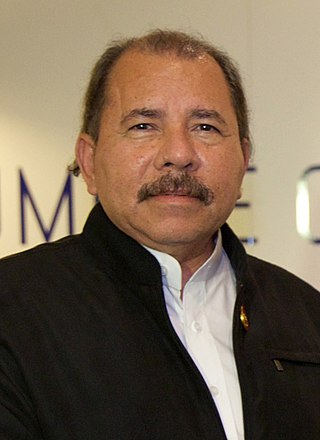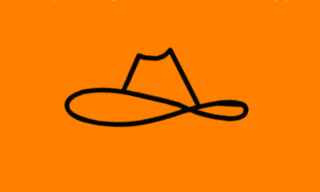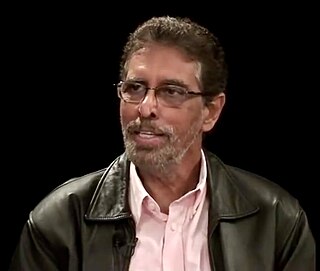
José Daniel Ortega Saavedra is a Nicaraguan politician serving as President of Nicaragua since 2007. Previously he was leader of Nicaragua from 1979 to 1990, first as coordinator (1979–1985) of the Junta of National Reconstruction, and then as President of Nicaragua (1985–1990). During his first term, he implemented policies to achieve leftist reforms across Nicaragua. In later years, Ortega's left-wing radical politics cooled significantly, leading him to pursue pro-business policies and even rapprochement with the Catholic Church. As a part of this, his government adopted strong anti-abortion policies, and his rhetoric took on a new, strongly religious tenor, despite formerly having professed atheism.

The Sandinista National Liberation Front is a left-wing political party in Nicaragua. Its members are called Sandinistas in both English and Spanish. The party is named after Augusto César Sandino, who led the Nicaraguan resistance against the United States occupation of Nicaragua in the 1930s.

The Nicaraguan Revolution encompassed the rising opposition to the Somoza dictatorship in the 1960s and 1970s, the campaign led by the Sandinista National Liberation Front (FSLN) to oust the dictatorship in 1978–79, the subsequent efforts of the FSLN to govern Nicaragua from 1979 to 1990, and the Contra War, which was waged between the FSLN-led government of Nicaragua and the United States–backed Contras from 1981 to 1990. The revolution marked a significant period in the history of Nicaragua and revealed the country as one of the major proxy war battlegrounds of the Cold War, attracting much international attention.

Herty Lewites Rodríguez was a Nicaraguan politician. He was Mayor of Managua and a candidate for president in the 2006 Nicaraguan general election when he died suddenly.
Pedro Joaquín Chamorro Cardenal was a Nicaraguan journalist and publisher. He was the editor of La Prensa, the only significant opposition newspaper to the long rule of the Somoza family. He is a 1977 laureate of the Maria Moors Cabot Prize of Columbia University in New York. He married Violeta Barrios de Chamorro, who later went on to become President of Nicaragua (1990–1997). In 1978, he was shot to death, one of the precipitating events of the overthrow of the Somoza regime the following year.

The Republic of Nicaragua elects on the national level a head of state – the president – and a unicameral legislature. The President of Nicaragua and his or her vice-president are elected on one ballot for a five-year term by the people.

The Junta of National Reconstruction was the provisional government of Nicaragua from the fall of the Somoza dictatorship in July 1979 until January 1985, with the election of Sandinista National Liberation Front’s Daniel Ortega as president.

General elections were held in Nicaragua on 5 November 2006. The country's voters went to the polls to elect a new President of the Republic and 90 members of the National Assembly. Daniel Ortega (FSLN) won the election with 37.99% of the vote, Eduardo Montealegre (ALN) trailing with 28.30%, José Rizo (PLC) with 27.1%, Edmundo Jarquín (MRS) with 6.29%, and Edén Pastora (AC) with 0.29%.

The Sandinista Renovation Movement is a Nicaraguan political party founded on 21 May 1995. It defines itself as a democratic and progressive party, made of women and men, which promotes the construction of a Nicaragua with opportunities, progress, solidarity, democracy and sovereignty.

Dora María Téllez Argüello is a Nicaraguan historian known for her involvement in the Nicaraguan Revolution. As a young university medical student in León in the 1970s, Téllez was recruited by the Sandinista National Liberation Front (FSLN). Téllez went on to become a comandante and fought alongside later president Daniel Ortega in the revolution that ousted dictator Anastasio Somoza Debayle in 1979. In the subsequent FSLN government, she served as Health Minister under Ortega and has also been an advocate for women's rights. She ultimately became a critic of repression and corruption under President Ortega and left the FSLN in 1995 to found the party Sandinista Renovation Movement (MRS), later renamed Unamos. Along with several other opposition figures, she was arrested in June 2021 by the Ortega government.
Jewish Nicaraguans or Nicaraguan Jews are Nicaraguans of Jewish ancestry who were born in or have immigrated to Nicaragua. They are part of the ethnic Jewish diaspora.
The following is a timeline of the history of the city of Managua, Nicaragua.
Daysi Ivette Torres Bosques is a Nicaraguan politician. She was mayor of Managua, the first female mayor of the city. She occupied the post from 2009 when the former mayor Alexis Argüello died until 2018. She is a member of the Sandinista National Liberation Front.

Luis Fernando Carrión Cruz is Nicaraguan politician. He is a former guerilla and one of the nine commandantes of the Sandinista (FSLN) National Directorate that overthrew the Somoza regime in 1979. Born to a wealthy, politically-connected family, he began college in the United States but returned to Nicaragua, first joining a radical Catholic group then the FSLN. He led the Carlos Roberto Huembes Eastern Front in Chontales during the final offensive of the revolution. He was a government minister and member of the FSLN National Directorate until 1995 when he split with party and became a cofounder of the Sandinista Renovation Movement (MRS).

Moisés Hassan Morales is a Nicaraguan politician. He was one of five members of the Junta of National Reconstruction that ruled the country from 1979 to 1984, following the fall of the Somozas regime.

Reyna Rueda Alvarado is a Nicaraguan politician. A member of the Sandinista National Liberation Front (FSLN), she has served as mayor of Managua since 2018.
Carlos Carrión Cruz is a Nicaraguan politician and civil engineer. From 1979 to 1985 he was head of the Sandinista Youth (JS), the founding national coordinator for the group. He was Mayor of Managua from 1988 to 1990, and also a member of the Sandinista National Liberation Front (FSLN).

Victor Hugo Tinoco Fonseca is a Nicaraguan politician and former Sandinista guerilla. He was Deputy Minister for Foreign Affairs with the Sandinista National Liberation Front, ambassador to the United Nations and a deputy in the National Assembly. In the late 1990s he grew critical of Daniel Ortega and was expelled from the party in 2005, joining the Sandinista Renovation Movement (MRS) instead and later its successor, the Democratic Renewal Union (Unamos) party. In June 2021, he was part of a wave of arrests of opposition figures, including seven aspiring opposition candidates for president in the 2021 Nicaraguan general election.
Pedro Joaquín Chamorro Barrios is a Nicaraguan journalist and politician. He began his career in journalism working at La Prensa, following the 1978 assassination of its editor, his father, Pedro Joaquín Chamorro Cardenal. Working on the side of the Contras in exile in the 1980s, he returned to the country in 1989 when his mother Violeta Barrios de Chamorro ran for president, and following her election, served as a Nicaraguan ambassador. He later became defense minister. In the 21st century, Chamorro has been a city councilor for Managua and deputy in the National Assembly, also for Managua. On 25 June 2021, he became part of a wave of arrests of opposition and civic figures in Nicaragua.

Jaime Chamorro Cardenal was a Nicaraguan newspaper editor and publisher. A civil engineer by training, journalism was the family business, as his father owned the newspaper La Prensa. Chamorro joined La Prensa in 1974, where he worked for 47 years and served as publisher for 28, from 1993 until his death in 2021.















